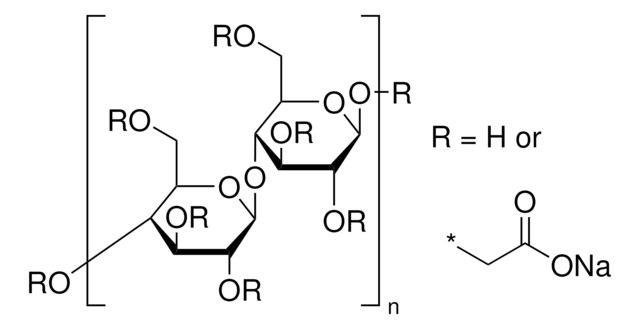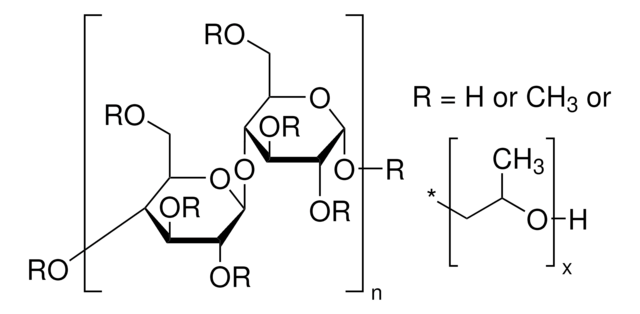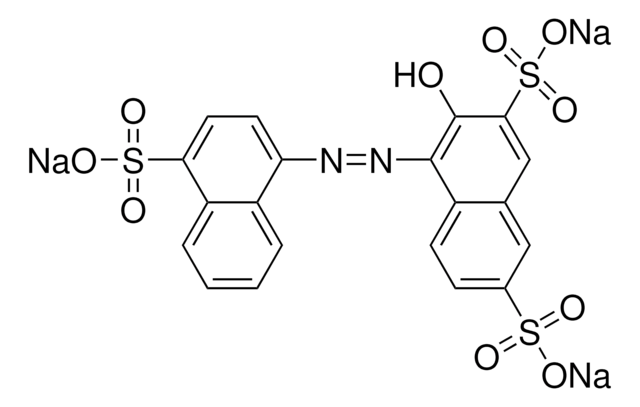C4888
Carboxymethylcellulose sodium salt
Medium viscosity
Synonym(s):
Sodium carboxymethylcellulose
Sign Into View Organizational & Contract Pricing
All Photos(3)
About This Item
Recommended Products
biological source
wood (pulp)
Quality Level
form
powder
color
light yellow
useful pH range
(20 °C, 10 g/L, 68 °F neutral)
viscosity
400-800 cP, 2 % in H2O(25 °C)(lit.)
mp
> 300.05 °C ((> 572.09 °F))
solubility
water: soluble
cation traces
Na: 6.5-9.5%
storage temp.
room temp
InChI
1S/C6H12O6.C2H4O2.Na/c7-1-3(9)5(11)6(12)4(10)2-8;1-2(3)4;/h1,3-6,8-12H,2H2;1H3,(H,3,4);
InChI key
DPXJVFZANSGRMM-UHFFFAOYSA-N
Looking for similar products? Visit Product Comparison Guide
General description
This product is a medium viscosity carboxymethylcellulose (CMC); the viscosity of a 2% solution in water at 25 C is 400-800 centipoise (cps). The viscosity is both concentration and temperature dependent. As the temperaure increases, the viscosity decreases. As the concentration increases, the viscosity increases.
Low, medium and high viscosity CMCs are all used as suspending agents. Low viscosity CMC is usually used in "thin" aqueous solutions. Medium viscosity CMC is used to make solutions that look like a syrup. High viscosity CMC is used to make a mixture, which resembles a cream or lotion.
Low, medium and high viscosity CMCs are all used as suspending agents. Low viscosity CMC is usually used in "thin" aqueous solutions. Medium viscosity CMC is used to make solutions that look like a syrup. High viscosity CMC is used to make a mixture, which resembles a cream or lotion.
Application
Soluble carboxymethylcelluloses (CM-cellulose; CMC) available in varying viscosities are used as viscosity modifiers (thickeners) to stabilize emulsions and as a chemical dispersants of oils and other carbon structures such as nanotubes. CMCs are used in the development of biostructures such as biofilms, emulsions and nanoparticles for drug delivery. Carboxymethylcellulose, medium viscosity, may be used to make solutions the consistency of syrup.
Preparation Note
The product is soluble in water (20 mg/ml).
The key to dissolving carboxymethylcellulose is to add the solid carefully to the water so that it is well dispersed (well-wetted). Adding the solid in portions may be necessary. Adding water to the dry solid produces a "clump" of solid that is very difficult to dissolve; the solid must be added to the water. Stir gently or shake intermittently; do not stir constantly with a magnetic stirring bar. High heat is not needed and may actually slow down the solubilization process. A mixing device, such as an impeller-type agitator which produces a vortex, would allow the powder to be drawn into the liquid, but it may produce some shearing.
The key to dissolving carboxymethylcellulose is to add the solid carefully to the water so that it is well dispersed (well-wetted). Adding the solid in portions may be necessary. Adding water to the dry solid produces a "clump" of solid that is very difficult to dissolve; the solid must be added to the water. Stir gently or shake intermittently; do not stir constantly with a magnetic stirring bar. High heat is not needed and may actually slow down the solubilization process. A mixing device, such as an impeller-type agitator which produces a vortex, would allow the powder to be drawn into the liquid, but it may produce some shearing.
Other Notes
To gain a comprehensive understanding of our extensive range of Polysaccharides for your research, we encourage you to visit our Carbohydrates Category page.
Storage Class Code
11 - Combustible Solids
WGK
WGK 1
Flash Point(F)
Not applicable
Flash Point(C)
Not applicable
Personal Protective Equipment
dust mask type N95 (US), Eyeshields, Gloves
Choose from one of the most recent versions:
Already Own This Product?
Find documentation for the products that you have recently purchased in the Document Library.
Customers Also Viewed
Megan E Spurgeon et al.
mBio, 10(2) (2019-03-07)
Papillomaviruses exhibit species-specific tropism, thereby limiting understanding and research of several aspects of HPV infection and carcinogenesis. The discovery of a murine papillomavirus (MmuPV1) provides the opportunity to study papillomavirus infections in a tractable, in vivo laboratory model. MmuPV1 infects
Jarod A Fincher et al.
The Journal of comparative neurology, 527(13), 2101-2121 (2018-10-26)
Mass spectrometry imaging (MSI) is capable of detection and identification of diverse classes of compounds in brain tissue sections, whereas simultaneously mapping their spatial distributions. Given the vast array of chemical components present in neurological systems, as well as the
Timothy Notton et al.
mBio, 12(1) (2021-01-21)
It has long been known that noncoding genomic regions can be obligate cis elements acted upon in trans by gene products. In viruses, cis elements regulate gene expression, encapsidation, and other maturation processes, but mapping these elements relies on targeted
Maninder Kaur et al.
Journal of food science and technology, 50(4), 809-814 (2014-01-16)
Effects of addition of different levels of gums (xanthan, carboxymethylcellulose and locust bean gum) on the pasting properties of tamarind kernel, potato and rice flour were studied by using Rapid Visco-Analyzer (RVA). Tamarind kernel powder (TKP) varied significantly (P < 0.05) from
Hanne R Johnsen et al.
International journal of molecular sciences, 15(1), 830-838 (2014-01-15)
Reliable, rapid and inexpensive detection of cellulolytic enzymes that can be used for a wide variety of biological and environmental samples are currently in high demand. Here, a new cellulase detection protocol is described that circumvents problems observed with popular
Our team of scientists has experience in all areas of research including Life Science, Material Science, Chemical Synthesis, Chromatography, Analytical and many others.
Contact Technical Service





